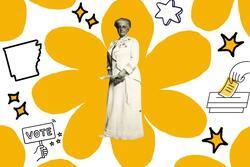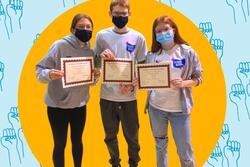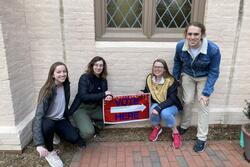Voting Rights in the U.S., From the Women’s Suffrage Movement to Now
In the last three federal elections, over half of eligible voters did not cast their ballots. While we've come a long way from white, male landowners being the only ones able to engage in this civic duty, the fight for voting equality in the United States has been seemingly everlasting.
Many people don’t vote because they believe their vote is insignificant. It’s true that one vote makes up a small percentage of the many, many votes across the country. But when tens of thousands of people operate on this belief, especially in swing states, elections can have an entirely different outcome because so many people choose not to use their voice.
But an even larger threat to our democracy is people who face insurmountable hurdles when attempting to vote. Across the U.S., forty-eight percent of unregistered voters listed a reason for not being registered other than simply not wanting to vote. These reasons included language barriers, and registration being inconvenient, among others.
For many low-income Americans, a demographic disproportionately made up of people of color and other minorities, taking time off work to vote or going through the often tedious process to register is out of the question. Yet, these are the same people who would most benefit from having their voices heard. Along with having an unfair influence on politics, citizens with more privilege and power have the resources to make other plans if elected officials don't do right by them. Obtaining an abortion in a different state, seeking gender-affirming care across the globe, or simply moving away when things become unbearable will always be more accessible to upper-class Americans.
As a feminist who cares about voting equality, it is clear to me that current voting rights advocacy is in part descended from the women’s suffrage movement. At first glance, it seems that suffragists would have set an important precedent for the further expansion of voting rights. Unapologetically radical and bold enough to speak their minds, these women were certainly not lacking in chutzpah. Although it took nearly seventy-five years, the suffragists ultimately gained the right to vote. So why is it that now, a century later, so many other oppressed groups are unable to vote? Perhaps we still have plenty to learn from the suffragists.
To start, the suffragists were far less concerned with being agreeable than many of us are today. While they certainly engaged in traditional lobbying, the U.S. women’s suffragists also staged intentionally divisive protests, gave politically charged speeches, and in many cases, were willing to be arrested for their cause. This is not to say that today’s advocates for voting equality are any less passionate, but that the current voting rights movement could benefit from being a little louder at times. Today, when it’s so easy to like, share, or repost the first thing we see, we must go beyond social media activism. Instead, write postcards, donate money, or write to your representatives. There are real, tangible actions we can take to create a lasting impact on communities affected by voter suppression; we just must be bold enough to take the next steps.
However, the suffragists also had an advantage with the simplicity of their cause. Achieving the vote wasn’t easy, but the argument over providing voting rights to women was relatively straightforward. It was an undisputed fact that women couldn’t vote in many states. Today, however, all adult citizens should be allowed to vote, but years of systemic oppression have impeded certain groups’ ability to do so, and explaining those complex factors is hard in a short Instagram post.
For example, in many states, incarcerated people can lose their right to vote upon conviction. This stems from the Reconstruction Era, as lawmakers quickly began implementing legislation that was designed to target Black citizens. As this was happening, felony disenfranchisement became more widespread, primarily limiting Black men’s right to vote. This strategy has persisted today, Black men face disenfranchisement at a rate that is seven percent higher than other people. Like many aspects of voter suppression, felony disenfranchisement is a conceptually and morally nuanced issue and requires a deep understanding to have meaningful conversations about it. The suffragists, although campaigning for their cause in tumultuous times, had a directness to their argument that allowed them to communicate more clearly. Yet, just because our current situation is more complicated, we are not excused from fearlessly supporting voting rights. If we could match the suffragists’ unreserved approach with a thoughtful understanding of today’s voting landscape, real change could be made.
Conversely, we can look at the suffragists’ greatest failures to improve today’s voting rights movement. As remarkable as their contributions were, many prominent leaders within the women’s suffrage movement didn’t care about voting rights beyond their own. Consistently excluding low-income women and women of color from their advocacy, their message was clear: only wealthy, white women needed to vote.
However, there were suffragists who thought more inclusively. One of these women was Maud Nathan, a Sephardic Jew from a prominent family. Beyond her commitment to women’s suffrage, she fought for workers’ rights and raised awareness about the mistreatment of working women. She used her privilege as a wealthy woman to shine light on the inequalities the working class faced and to advocate for better working conditions in factories. Nathan led several groups striving for fair worker treatment and published articles that exposed factory owners and educated the public. Maud Nathan recognized the hardships of these women, many of whom were newly immigrated Ashkenazi Jews, and she strove to make a difference. At a time when many wealthy Jews looked down on Jewish immigrants, Nathan’s willingness to stand with workers was notable. Maud Nathan’s values should be applied to today’s cause; fighting for the rights of others must be the guiding principle in the voting rights movement.
In an issue so intertwined with privilege and lack thereof, equal voting rights are contingent on our dedication to people outside of our own bubbles. Our democracy thrives when everyone has a voice—true equality cannot be reached if millions of voters are silenced. As 2024 approaches and elections regain their position at the forefront of our minds, I urge everyone who is able to vote. Vote for those who cannot, and use your vote to build a more just future.
This piece was written as part of JWA’s Rising Voices Fellowship.







